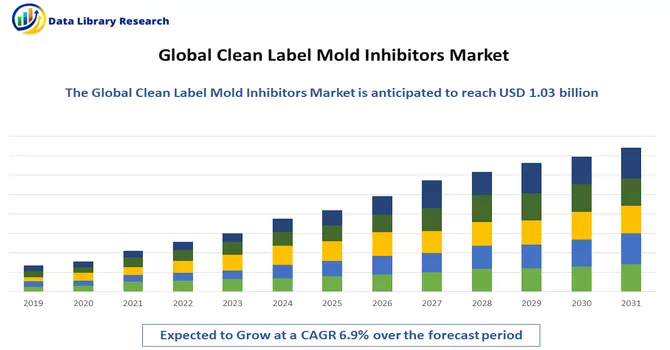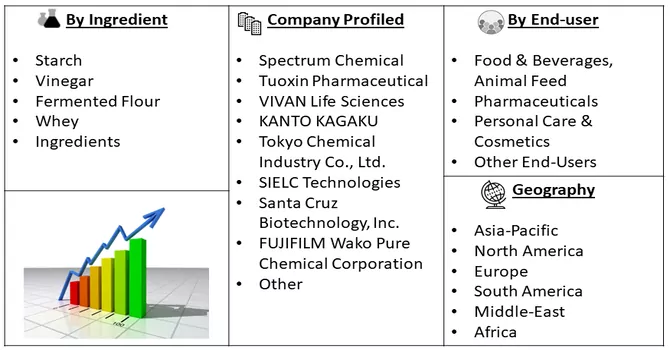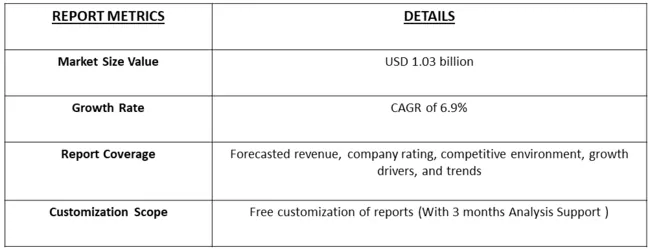The global clean label mold inhibitors market size was estimated at USD 1.03 billion in 2023 and is projected to grow at a compound annual growth rate (CAGR) of 6.9% from 2024 to 2031.

Get Complete Analysis Of The Report - Download Free Sample PDF
Clean label mold inhibitors refer to natural or minimally processed substances used in the food industry to prevent the growth of mold and extend the shelf life of products while adhering to clean label principles. These inhibitors are typically free from synthetic or artificial additives, artificial preservatives, and chemical compounds, aligning with consumer preferences for transparent and easily recognizable ingredients. Common clean label mold inhibitors include natural extracts, organic acids, and plant-derived compounds that serve to inhibit mold growth in various food products. This approach supports the production of safer, more natural food items without compromising on quality, thereby meeting the increasing consumer demand for clean and minimally processed foods.
The Clean Label Mold Inhibitors market is experiencing robust growth driven by several key factors. Firstly, the escalating consumer demand for clean and minimally processed food products, characterized by transparent ingredient lists and natural preservatives, is propelling the market forward. Increasing health consciousness and awareness of the potential health risks associated with synthetic preservatives are prompting consumers to seek products with clean label mold inhibitors. Additionally, the growing trend toward organic and natural food options is further fueling the demand for clean label solutions in the food industry. The emphasis on food safety and the extension of shelf life without compromising on product quality are crucial factors fostering the adoption of clean label mold inhibitors. Furthermore, regulatory support and industry initiatives promoting clean label practices are contributing to market growth. As consumer preferences continue to evolve, manufacturers are increasingly incorporating clean label mold inhibitors to meet the demand for safer, healthier, and more transparent food options.
Market Segmentation: The Global Clean label mold inhibitors Market is Segmented by Ingredient (Starch, Vinegar, Fermented Flour, Whey and Other Ingredient), End-Users (Food & Beverages, Animal Feed, Pharmaceuticals, Personal Care & Cosmetics, and Other End-Users) and Geography (North America, Europe, Asia-Pacific, South America, and Africa). The market size and forecast are provided in terms of value (USD million) for the above segments.

For Detailed Market Segmentation - Download Free Sample PDF
The Global Clean Label Mold Inhibitors Market is witnessing notable trends driven by a consumer shift towards clean and transparent food products. With an increasing emphasis on natural and sustainable ingredients, the market is experiencing a surge in demand for clean label mold inhibitors that offer effective preservation without compromising product integrity. Food technology innovations, as demonstrated by startups like BioVeritas, LLC, are introducing novel solutions derived from natural sources, aligning with the clean label principles. These innovations address the growing concerns related to synthetic additives and preservatives, reflecting a broader trend in the food industry. Additionally, the demand for clean label mold inhibitors is gaining traction due to rising health consciousness and a preference for minimally processed foods. As the market continues to evolve, companies are strategically focusing on product development, eco-friendly processes, and partnerships to meet the increasing consumer expectations for clean and sustainable mold inhibition solutions.
Market Drivers:
Consumer Demand for Clean Label Products
The surge in consumer preference for clean label products is a significant driver shaping the Clean Label Mold Inhibitors Market. This trend is characterized by a growing inclination toward food items that boast natural, recognizable, and transparent ingredients. With consumers becoming increasingly health-conscious, there is a notable shift away from products containing synthetic additives. In response to this demand, there is a rising interest in mold inhibitors derived from natural sources, as they align with the principles of clean labeling. These inhibitors, often obtained from plant extracts or other naturally occurring substances, offer a safer and more consumer-friendly alternative to traditional chemical preservatives. Manufacturers acknowledging and responding to this consumer-driven movement are actively contributing to the expansion of the Clean Label Mold Inhibitors Market. By offering products that meet the criteria of clean labeling, these manufacturers not only enhance the safety and quality of food products but also cater to the evolving preferences of health-conscious consumers seeking transparent and wholesome options.
Growing Awareness of Health and Wellness
The adoption of clean label mold inhibitors is significantly influenced by the heightened awareness of health and wellness among consumers. As individuals become more conscientious about their dietary choices, there is a discernible trend of scrutinizing ingredient lists and actively avoiding food products containing chemical preservatives. Consumers are increasingly inclined towards options that align with their aspirations for overall well-being. Clean label mold inhibitors, derived from natural extracts and processed minimally, emerge as a compelling solution that resonates with this health-conscious consumer base. These inhibitors not only address the imperative of ensuring food safety by inhibiting mold growth but also align with the broader narrative of promoting health and wellness. The market is experiencing a notable boost from the recognition that clean label mold inhibitors offer a healthier alternative to conventional options laden with synthetic additives. The natural origins and minimal processing of these inhibitors contribute to their appeal, as they cater to the preferences of consumers seeking clean, wholesome, and transparent choices. The positive association of clean label mold inhibitors with health and wellness has led to their increased adoption across diverse food and beverage applications. Manufacturers and brands responding to this consumer-driven demand are contributing to the market's growth, emphasizing the dual benefits of ensuring food safety while enhancing the nutritional profile of products, thereby fostering the overall well-being of consumers.
Market Restraints:
Challenges in Efficacy and Shelf Life
The efficacy and shelf life of clean label mold inhibitors pose a notable restraint in the market. While consumers increasingly favor natural and clean label alternatives, there are challenges in ensuring that these options consistently match the effectiveness of synthetic counterparts. Natural ingredients, by their nature, may exhibit variations in their antimicrobial properties, which can impact the inhibitors' ability to prevent mold growth uniformly across different products and conditions. Maintaining stability and achieving a prolonged shelf life without compromising product quality becomes a critical challenge for manufacturers. The inherent variability in natural ingredients can influence the inhibitors' performance under various storage conditions, affecting their overall effectiveness over time. This constraint necessitates continuous research and development efforts within the industry to address these challenges and optimize the performance of clean label mold inhibitors to meet stringent industry standards. Ongoing innovation and advancements in formulation techniques are crucial to overcome these limitations. Manufacturers must invest in R&D to develop robust clean label mold inhibitors that not only align with consumer preferences but also deliver consistent and reliable performance throughout the product's shelf life. Striking a balance between natural, clean label criteria and the efficacy and stability required for effective mold inhibition remains a key challenge that the industry needs to address to ensure the successful adoption of clean label mold inhibitors in various food and beverage applications.
The Global Clean Label Mold Inhibitors Market experienced notable impacts from the COVID-19 pandemic. Supply chain disruptions, particularly in the early stages of the crisis, posed challenges for manufacturers, affecting production and potentially impacting the availability of clean label mold inhibitors. Changes in consumer behavior, marked by an increased focus on health and wellness, influenced purchasing patterns, with potential shifts in demand for premium clean label products. On a positive note, the pandemic heightened global health consciousness, fostering a sustained interest in clean and transparent food products, including mold inhibitors. The challenges also accelerated innovation within the industry, driving advancements in formulations and production processes. As the market adapts to the post-pandemic landscape, the enduring focus on health-conscious choices may continue to drive demand for clean label mold inhibitors.
Segmental Analysis:
Fermented Flour Segment is Expected to Witness Significant Growth Over the Forecast Period
The incorporation of fermented flour in the Global Clean Label Mold Inhibitors Market reflects a growing trend in response to consumer demands for natural and clean label alternatives. Fermented flour, derived from natural fermentation processes, aligns with the clean label principles by offering an effective and natural mold inhibition solution. As an innovative ingredient, it not only caters to the demand for clean and recognizable components but also contributes to enhanced product quality. The fermentation process introduces beneficial microorganisms that not only impart unique flavors and textures but also act as natural preservatives, inhibiting mold growth. This aligns with the broader market trends favoring clean label mold inhibitors, as manufacturers seek sustainable and health-conscious solutions. The inclusion of fermented flour presents an opportunity for industry players to diversify their product offerings and tap into the rising consumer preference for clean label ingredients in the dynamic Global Clean Label Mold Inhibitors Market.
Pharmaceuticals Segment is Expected to Witness Significant Growth Over the Forecast Period
The pharmaceutical industry's role in the Global Clean Label Mold Inhibitors Market is crucial, as the demand for clean and transparent ingredients extends beyond the food sector. With a heightened emphasis on health and wellness, pharmaceutical manufacturers are increasingly exploring clean label mold inhibitors for medications and healthcare products. The use of natural and recognizable ingredients aligns with the clean label trend, ensuring that pharmaceuticals not only meet stringent safety standards but also resonate with consumer preferences. As consumers seek medication options with fewer synthetic additives, the incorporation of clean label mold inhibitors in pharmaceutical formulations becomes pivotal. This shift reflects a broader industry acknowledgement of the importance of natural and transparent ingredients in promoting overall well-being. The pharmaceutical sector's engagement in the clean label movement contributes significantly to the growth and evolution of the Global Clean Label Mold Inhibitors Market, demonstrating the adaptability of clean label principles across diverse industries.
North America Region is Expected to Witness Significant Growth Over the Forecast Period
In the North America region, the Global Clean Label Mold Inhibitors Market is experiencing robust growth driven by a confluence of factors. Consumers in North America are increasingly prioritizing health-conscious choices, prompting a surge in demand for clean label products, including mold inhibitors. The region's stringent regulatory environment further accelerates the adoption of clean label solutions as manufacturers strive to align with transparency requirements. North American consumers' discerning preferences for natural and recognizable ingredients propel the market, with clean label mold inhibitors gaining prominence across diverse food and beverage applications. The region's innovative food industry, coupled with a heightened focus on sustainability and wellness, positions North America as a key player in the global clean label movement. As manufacturers in the region continue to respond to evolving consumer trends, North America's influence on the Global Clean Label Mold Inhibitors Market remains pivotal, shaping the trajectory of the market in line with the region's dynamic preferences and regulatory landscape.

Get Complete Analysis Of The Report - Download Free Sample PDF
The analyzed market exhibits a high degree of fragmentation, primarily attributable to the presence of numerous players operating on both a global and regional scale. The competitive landscape is characterized by a diverse array of companies, each contributing to the overall market dynamics. This fragmentation arises from the existence of specialized solution providers, established industry players, and emerging entrants, all vying for market share. The diversity in market participants is underscored by the adoption of various strategies aimed at expanding the company presence. On a global scale, companies within the studied market are strategically positioning themselves through aggressive expansion initiatives. This often involves entering new geographical regions, targeting untapped markets, and establishing a robust global footprint. The pursuit of global expansion is driven by the recognition of diverse market opportunities and the desire to capitalize on emerging trends and demands across different regions. Simultaneously, at the regional level, companies are tailoring their approaches to align with local market dynamics. Regional players are leveraging their understanding of specific market nuances, regulatory environments, and consumer preferences to gain a competitive edge. This regional focus allows companies to cater to the unique needs of local clientele, fostering stronger market penetration. To navigate the complexities of the fragmented market, companies are implementing a range of strategies. These strategies include investments in research and development to stay at the forefront of technological advancements, mergers and acquisitions to consolidate market share, strategic partnerships for synergies, and innovation to differentiate products and services. The adoption of such multifaceted strategies reflects the competitive nature of the market, with participants continually seeking avenues for growth and sustainability. In essence, the high fragmentation in the studied market not only signifies the diversity of players but also underscores the dynamism and competitiveness that drive ongoing strategic maneuvers. As companies explore various avenues for expansion, the market continues to evolve, presenting both challenges and opportunities for industry stakeholders.
Financials, strategy maps & products of these clean label mold inhibitor companies are analyzed to map the supply network.
Recent Development:
1) In July 2023, the food technology startup, BioVeritas, LLC, unveiled a groundbreaking clean label mold inhibitor at IFT FIRST, the annual meeting of the Institute of Food Technologists held in Chicago from July 16-19. The newly introduced ingredient, derived from a cultured vegetable oil extract through a proprietary upcycling process, offers a sustainable alternative to traditional mold inhibitors like calcium propionate. In baked food applications, this innovative solution from the Bryan, Texas-based company demonstrates no substantial differences in texture or flavor, as validated by the findings of a third-party study conducted by an independent university sensory research laboratory. This pioneering clean label mold inhibitor addresses the increasing consumer demand for natural and transparent ingredients in food products, thereby contributing significantly to the growth and advancement of the clean label mold inhibitors market.
2) In July 2023, BioVeritas, LLC, a pioneering food technology startup, made a significant debut at IFT FIRST, the Institute of Food Technologists' annual meeting in Chicago. The company unveiled a revolutionary clean-label mold inhibitor, marking a substantial advancement in the industry. This innovative ingredient, derived from a cultured vegetable oil extract using BioVeritas' proprietary upcycling process, emerges as a sustainable alternative to conventional mold inhibitors like calcium propionate. Specifically designed for baked food applications, this breakthrough solution from the Bryan, Texas-based company showcases remarkable characteristics, with no discernible differences in texture or flavor—a validation supported by the results of a comprehensive third-party study conducted by an independent university sensory research laboratory. The introduction of this clean-label mold inhibitor caters directly to the escalating consumer demand for natural and transparent ingredients in food products. As a result, it not only addresses key market trends but also significantly contributes to the global clean-label mold inhibitor market's growth and advancement, positioning BioVeritas as a noteworthy player in the evolving landscape of clean-label food technology.
Q1. What was the Clean Label Mold Inhibitors Market size in 2023?
As per Data Library Research the global clean label mold inhibitors market size was estimated at USD 1.03 billion in 2023
Q2. At what CAGR is the Clean Label Mold Inhibitors market projected to grow within the forecast period?
Clean Label Mold Inhibitors Market is projected to grow at a compound annual growth rate (CAGR) of 6.9% over the forecast period.
Q3. What are the factors driving the Clean Label Mold Inhibitors market?
Key factors that are driving the growth include the Consumer Demand for Clean Label Products and Growing Awareness of Health and Wellness.
Q4. What Impact did COVID-19 have on the Clean Label Mold Inhibitors Market?
The Global Clean Label Mold Inhibitors Market experienced notable impacts from the COVID-19 pandemic. For detailed insights request a sample here.
Data Library Research are conducted by industry experts who offer insight on industry structure, market segmentations technology assessment and competitive landscape (CL), and penetration, as well as on emerging trends. Their analysis is based on primary interviews (~ 80%) and secondary research (~ 20%) as well as years of professional expertise in their respective industries. Adding to this, by analysing historical trends and current market positions, our analysts predict where the market will be headed for the next five years. Furthermore, the varying trends of segment & categories geographically presented are also studied and the estimated based on the primary & secondary research.
In this particular report from the supply side Data Library Research has conducted primary surveys (interviews) with the key level executives (VP, CEO’s, Marketing Director, Business Development Manager and SOFT) of the companies that active & prominent as well as the midsized organization
FIGURE 1: DLR RESEARH PROCESS

Extensive primary research was conducted to gain a deeper insight of the market and industry performance. The analysis is based on both primary and secondary research as well as years of professional expertise in the respective industries.
In addition to analysing current and historical trends, our analysts predict where the market is headed over the next five years.
It varies by segment for these categories geographically presented in the list of market tables. Speaking about this particular report we have conducted primary surveys (interviews) with the key level executives (VP, CEO’s, Marketing Director, Business Development Manager and many more) of the major players active in the market.
Secondary ResearchSecondary research was mainly used to collect and identify information useful for the extensive, technical, market-oriented, and Friend’s study of the Global Extra Neutral Alcohol. It was also used to obtain key information about major players, market classification and segmentation according to the industry trends, geographical markets, and developments related to the market and technology perspectives. For this study, analysts have gathered information from various credible sources, such as annual reports, sec filings, journals, white papers, SOFT presentations, and company web sites.
Market Size EstimationBoth, top-down and bottom-up approaches were used to estimate and validate the size of the Global market and to estimate the size of various other dependent submarkets in the overall Extra Neutral Alcohol. The key players in the market were identified through secondary research and their market contributions in the respective geographies were determined through primary and secondary research.
Forecast Model
